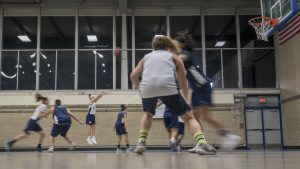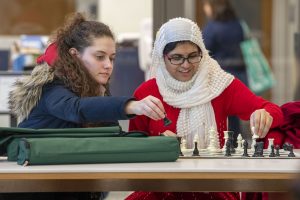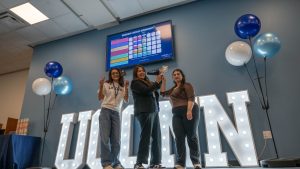Student Activities Building a Sense of Belonging at UConn’s Regional Campuses
To watch Aylanie Bonilla in action as a UConn Waterbury student ambassador, it’s easy to imagine she’s always been the sociable go-getter who leads campus tours, meets with high schoolers, and participates in multiple clubs.
But it’s those very activities she credits with giving her a sense of belonging at UConn, where the Storrs campus felt so large to her in her first semester that she transferred to her hometown campus in Waterbury.
Like thousands of other students at UConn’s four regional campuses, Bonilla ’26 (CLAS) found her voice and her community through student clubs, an on-campus learning community, and other extracurricular activities.
She jokes that she’s not sure many of her high school teachers would even remember her name since she was so shy and barely spoke up in class. They’d certainly be surprised now to see her comfortably chatting with strangers, joining clubs, and serving as a program assistant for the Walkbury community initiative.
“When I became an orientation leader on campus, I just started talking, and I haven’t really stopped,” says Bonilla ’26 (CLAS). “It was really easy to get involved here and to make friends in the clubs and the classes. The feeling is like being part of a big family.”

Overall, about 5,100 of UConn’s estimated 19,800 undergraduates count one of those locations as their home campus.
With the vast majority of all regional campus students being Connecticut natives, those locations offer the benefits of a UConn education with the convenience of being in communities where students can live, work, and socialize.
Like the flagship Storrs campus, the campuses in Avery Point, Hartford, Stamford, and Waterbury each have student government groups, academic and social clubs, and a range of formal and informal activities.
Regional campus students can also participate in many of the clubs based at Storrs, including having local versions at their own locations. The events are tailored to the unique goals and experiences shared by regional campus students, many of whom balance their classes and clubs with jobs, family obligations, and community activities.
“It is widely known from student development research, along with the experience of our own students, that engagement in clubs and organizations has dramatic and positive impact on a student’s experience. They also help UConn to attract increasing numbers of top students to our campuses,” says Nathan Fuerst, UConn’s vice president for student life and enrollment.
Having robust campus activities also helps UConn retain and continue to improve its strong retention and graduation rates as students meet peers, mentors, and others to whom they can turn for help if they’re facing obstacles.
UConn has prioritized a commitment to expanding its regional campus offerings as part of its Strategic Plan, building on each location’s strengths to make them destinations for students interested in specific majors or programs.
The clubs are a perfect complement to that work, and part of a wider network of services that also include more advising support and expanded on-site Student Health & Wellness offerings such as nurse navigators, mental health clinical care case workers, and health promotion programs.

In addition to the academic and social clubs, each regional campus offers library and research resources, small courses with experienced faculty, and programs to help students engage with the communities in which the campuses are located.
Each campus offers clubs in which students connect with each other through common cultural backgrounds, volunteer activities, religious affiliations, and other attributes. The clubs also build on the academic, social, and community ties unique to each regional campus.
At UConn Avery Point, for instance, clubs for sailing and paddling, scuba diving, and marine sciences help students take advantage of the waterfront location and resources – in addition to clubs for learning, relaxation, and cultural connections.
UConn Hartford’s location in Connecticut’s capital city provides an ideal setting for clubs helping students advance their aspirations in business, social work, healthcare and other professions, while also offering fun opportunities to connect through gaming, dance, and other pursuits.
At the Stamford campus, students participate in a variety of political, cultural, and professional clubs that take advantage of its curriculum and location, and they can also have some fun in groups for debating, K-pop music, sports, and other activities.
Bonilla, the UConn Waterbury student, has been active in the K-pop group on that campus, where students participate in clubs that range from a business society focused on networking and professional development to ping pong and improv drama.
The campuses also provide many informal opportunities for students to connect, be it through casual slime-making sessions or building Chipotle-style burrito bowls – recent activities at UConn Waterbury that drew scores of students, including a line that stretched down the hallway for the burrito bowls.

Bonilla is transferring to UConn Stamford this fall and expects to remain just as actively involved there, finishing her degree in communications and looking forward to finding the same sense of community that she discovered in Waterbury.
“I’m excited to be in a new area and meet new people, and to look for an internship in my field,” she says. “I know it’s a bigger campus than Waterbury, but I also feel like I have a good start and it’ll be fun to get really involved there like I’ve been here.”
Latest UConn Today
- Two UConn School of Nursing Students Attend a ‘Once in a Lifetime’ Conference Visiting State Senators and Representatives on Capitol HillA different side to the nursing profession.
- UConn Health Half Marathon: Motivational Mantras That WorkLong distance running is a challenge both physically and mentally. Some runners use phrases or “mantras” to keep them focused on the present and to build resilience on especially difficult runs. UConn Health internal medicine physician, Jennifer Ozimek, has run the UConn Health Half Marathon in Simsbury for the past 5 years and has several […]
- Senior Design Team Develops Personalized Breast Self-Exam Virtual Reality Training SimulatorA haptic glove uses a sophisticated combination of microprocessors, balloons, and air pumps to exert force onto the fingertips, simulating the feeling of a breast exam.
- CoE Group Shares Fuel Cell Aviation Research, Networks at DOE Energy SummitA UConn team joined energy scientists, technologists, engineers, and industry leaders at the Advanced Research Projects Agency-Energy (ARPA-E) Innovation Summit to collaborate on the future of energy innovation
- Commencement Student Speaker Spotlight: Kristina DuboisDubois is a DMD candidate in the UConn School of Dental Medicine and is a student speaker for UConn Health’s 54th Commencement on May 12, 2025
- Imagine Shakespeare in Front of a PS4 – Probably Not, But the Bard Has Influenced Gaming'Not all literature is so easily translated into new forms and new media. Most of Shakespeare can be adapted to pretty much any time and place'













